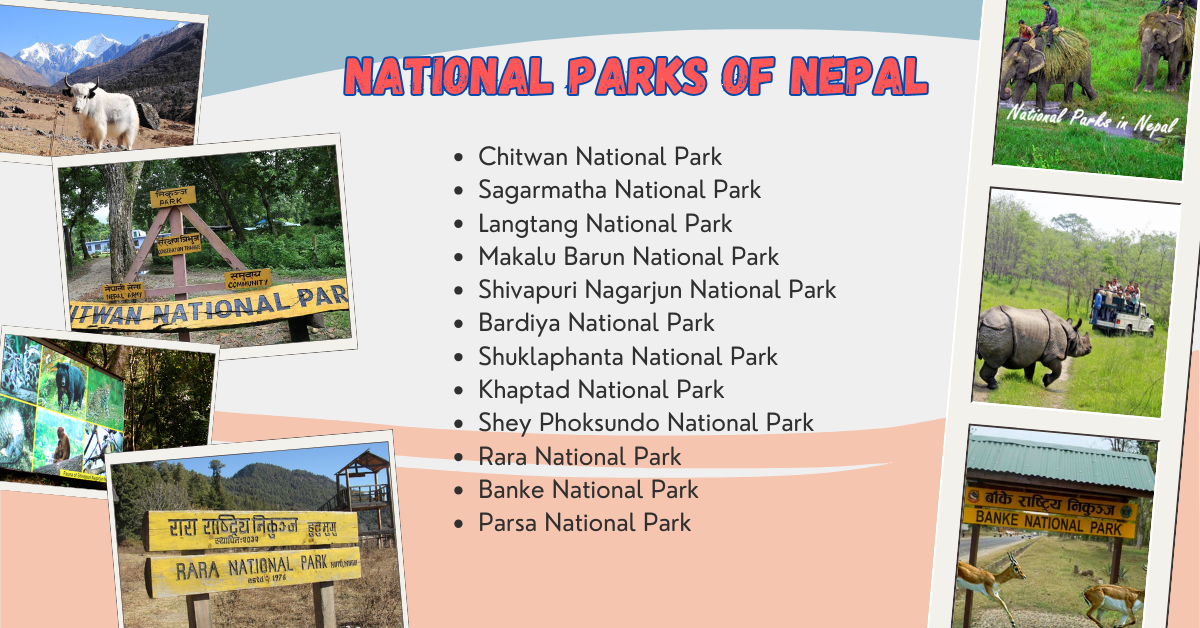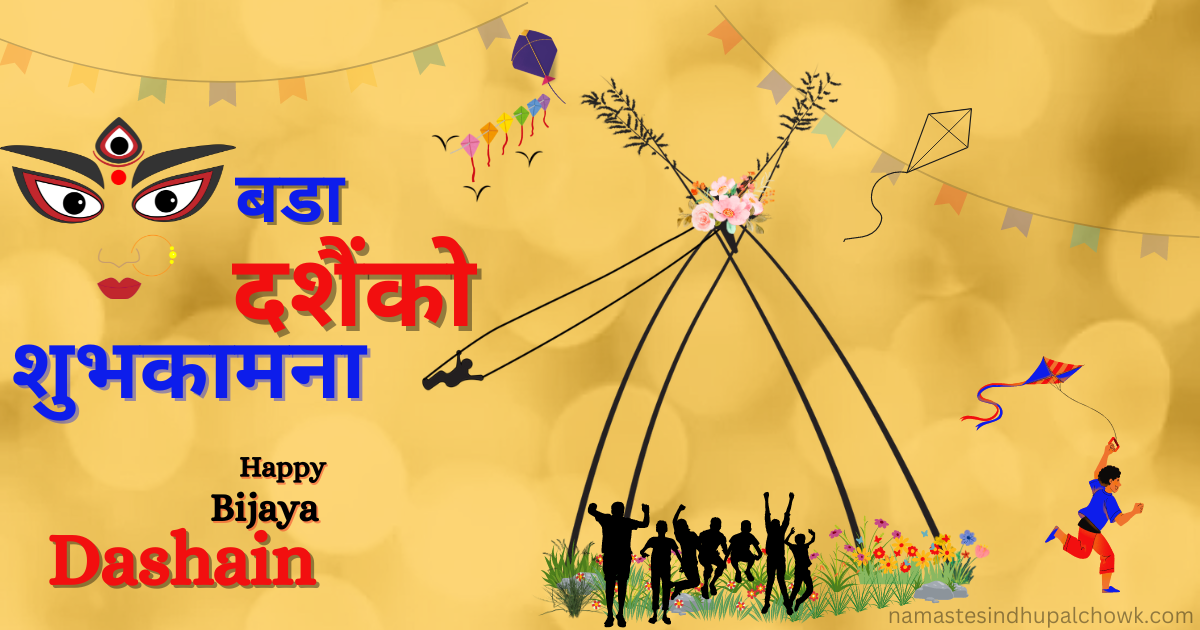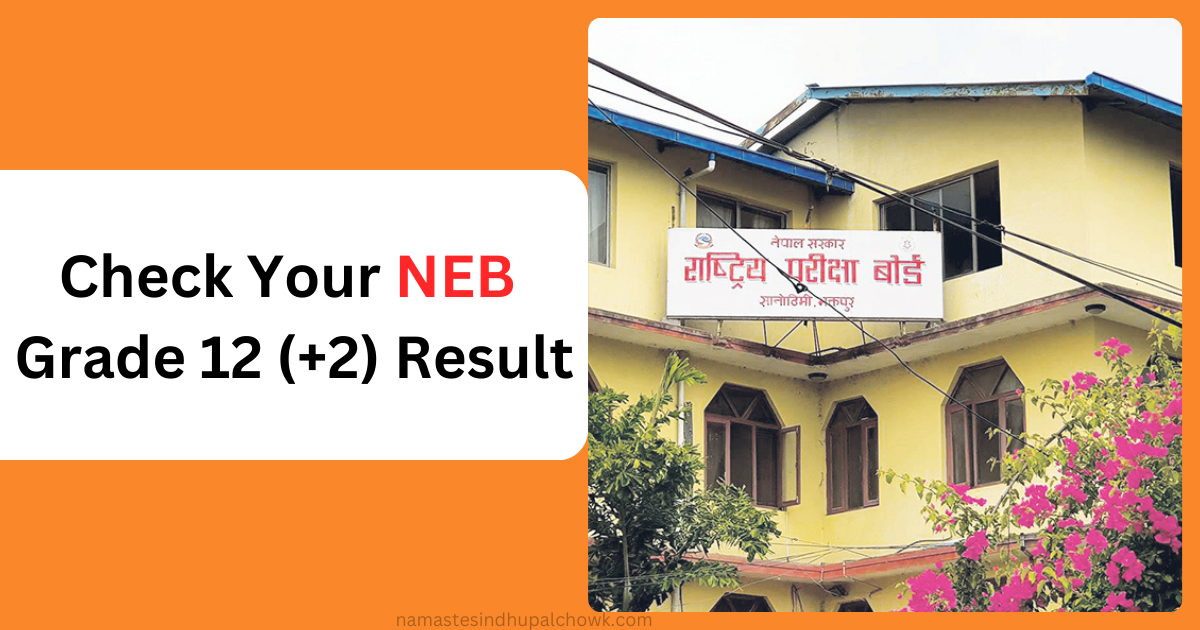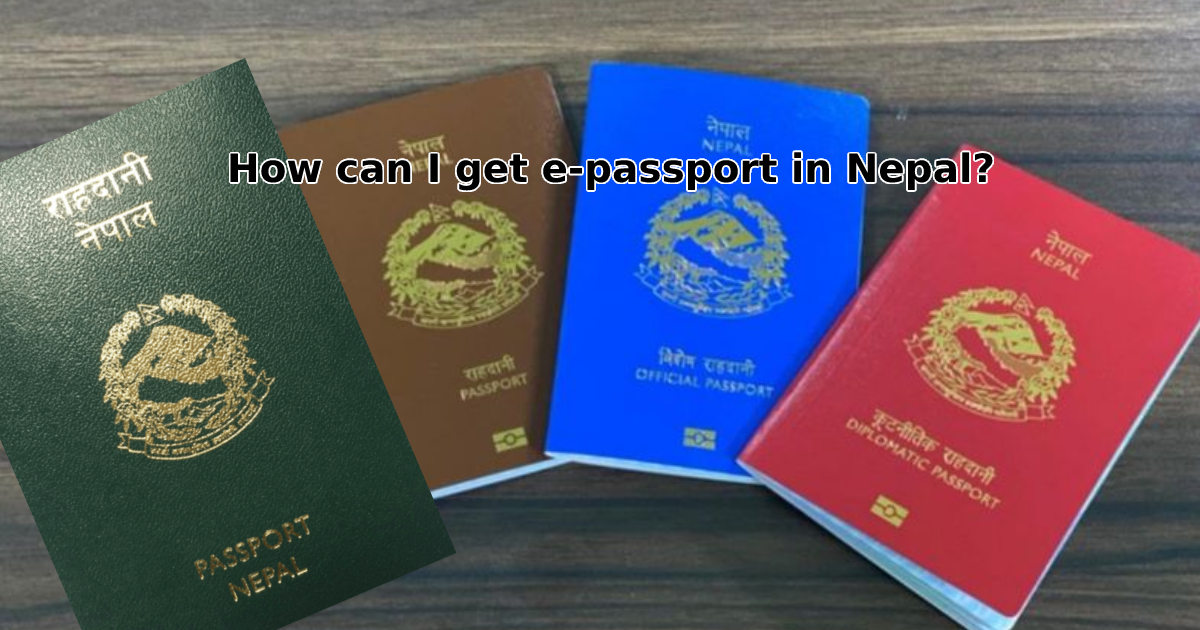Chitwan National Park, Khaptad National Park, Shey Foksundo National Park, Sagarmatha National Park, Langtang National Park, Rara National Park, Bardiya National Park, Banke National Park, Shivapuri-Nagarjuna National Park, Makalu-Burun National Park, Shuklaphata National Park, and Parsa National Park are the 12 National Parks in Nepal.
Nepal is a country with biological diversity in terms of geography. A small land has religious, cultural, ethnic, and lifestyle as well as natural diversity. Spreading from 59 meters above sea level to the world's highest peak, Everest, Nepal has an amazing variety of nature and geography. Different places in Nepal's geography like weather, soil, place, sand, tar, forest, etc. have their own diversity. It is not only the people who live in this diversity but the birds, animals, wild animals, mammals, etc. found here have a great diversity.
More than 40% of Nepal is covered by forest. Similarly, there are more than 6000 small and big rivers in Nepal. Different types of birds, wild animals, reptiles, and mammals live in different places such as rivers, forests, lakes, ponds, glaciers, snow lakes, and wetlands. And, in this place, different types of plants, herbs, trees, charkoshe bushes, etc. are found. Such different types of animals, plants, and animals are known to disappear with the change of time and human development. Therefore, to protect these natural elements from extinction, develop and protect them, National Parks, Conservation Areas, Ramsar, and conservation area concepts have been started. Likewise, its aim is to support the country's economy by promoting eco-tourism.
National Park, Conservation Area, Wildlife Reserve Area & Hunting Reserve in Nepal
Nepal currently has a total of 12 national parks, 6 protected areas, 1 wildlife reserve, 1 hunting reserve, 10 Ramsar sites, and 12 Madhyawarti. These areas play a very important role in the protection of wild animals, plants, fish, herbs, soil, plants, etc. All these areas and protected areas are under the National Protected Areas and Wildlife Conservation Department under the Ministry of Forestry and Environment of the Government of Nepal. This department was established in the year 2037 with the aim of providing direct assistance in the protection, enhancement, and control of National Park, conservation areas.
Their aim is to completely discourage poachers from stealing from the national park and to play an effective role in conservation by protecting these places. Since 2032, the Nepali Army has been deployed in every protected area of Nepal to support this objective.
There are 118 types of ecosystems in Nepal now. Among them, 80 types of ecosystems are included in the National Parks and Conservation Areas. Similarly, Protected areas in Nepal are spread over 23.39 percent of the total land area i.e. 34419.75 square kilometers.
National Parks, Wildlife and Hunting Reserves, Conservation Areas have been established with one purpose. That one purpose is to protect wildlife, natural resources, plants, and ecological systems. However, there are some differences between them based on human activities, ecological systems, and regulations. That difference will be clear from the brief introduction given below.
National Parks of Nepal
A "National Park" refers to a designated area reserved for the protection, control, and conservation of flora, and fauna, use of plants, animals, picturesque landscapes, and the overall natural surroundings. National parks generally impose stringent rules aimed at reducing human influence and safeguarding the area's original condition. Pastimes like hiking, camping, observing wildlife, and capturing nature through photography are popular within national parks. Nevertheless, actions that might damage the environment, like hunting and extracting resources, are typically banned in national parks.
A certain community, village, resort, hotel, homestay, etc. are included within the National National Park. Here you can observe natural resources, flora and fauna. You can go here only by paying the fixed entrance fee set by the government.
Chitwan National Park is the first national Park of Nepal. It was established in the year 2030. Everest National Park is the highest national park in the world. The highest peak Mount Everest is located in this national park. Similarly, She-Foksudo National Park is the largest. And, Rara National Park is the smallest National Park. Similarly, the youngest National Park of Nepal is Parsa National Park.
Conservation Areas
A Conservation area is a place where wildlife, art, culture, biological diversity, natural resources, and ecological systems are protected in a planned manner. It also aims to use natural resources in a balanced manner. It includes various national parks and wildlife reserves. The rules here may be slightly different from the national parks. Annapurna, Kanchenjunga, Manaslu, Blackbuck, Api Nampa, and Gaurishankar are the conservation areas of Nepal.
Wildlife Reserve Area
A wildlife reserve is a special place reserved for different types of birds and animals. In this place, the space needed for the habitat of wild animals is allocated. Likewise, The purpose of the reservation area is to protect the endangered wild animals and create a suitable environment for them to live in. Koshi Tappu is the only wildlife reserve centre in Nepal.
Hunting Reserve
A hunting reservation is a certain place reserved for hunters to hunt animals. Where the hunters can hunt with the permission of the concerned body. For this, hunters have to pay certain fees and follow various rules and instructions. There is only one Dhorpatan hunting reserve in Nepal.
List of National Parks in Nepal
| S.N. | National Park | Establish Date (BS/AD) | Total Area (Sq.KM) | Cover District |
|---|---|---|---|---|
| 1. | Chitwan | 2030BS / 1973 AD | 952.63 | Chitwan, Nawalpur, Parsa, Makawanpur |
| 2. | Khaptad | 1984 AD | 225 | Baghang, Bajura, Achham, Doti |
| 3. | Shey Foksundo | 1984 AD | 3555 | Dolpa, Mugu |
| 4. | Sagarmatha | 1976 AD | 1148 | Solukhumbu |
| 5. | Langtang | 1976 AD | 1710 | Nuwakot, Sindhupalchowk, Rasuwa |
| 6. | Rara | 1976 AD | 106 | Mugu, Jumla, Humla |
| 7. | Bardiya | 1988 AD | 968 | Bardiya |
| 8. | Banke | 2010 AD | 550 | Banke, Salyan, Dang |
| 9. | Shivapuri - Nagarajuna | 2002 AD | 159 | Kathmandu, Nuwakot, Sindhupalchowk |
| 10. | Makalu- Burun | 1992 AD | 1500 | Solukhumbu, Sankhuwasabha |
| 11. | Shuklaphata | 2033 BS/ 1976 AD | 305 | Kanchanpur |
| 12. | Parsa | 1984 AD | 627.39 | Makawanpur, Parsa, Bara |
Here we are going to discuss 12 national parks of Nepal one by one in details.
1. Chitwan National Park
Chitwan National Park is the first national park in Nepal. It was established in the year 2030. It is located in the Chitawan, Makwanpur and Parsa districts in Nepal's Inner Madhesh lowland and Terai regions. Its area is 932 square kilometres. And, The area of the buffer zone is 750 square km.
Similarly, in 1984, Chitwan National Park was included in the UNESCO World Heritage List. Leopards, one-horned rhinoceros, crocodiles, elephants, leopards, peacocks, etc. are the main wild animals and birds found here. Similarly, Charkoshe Zadi, Bisahjari Lake, Meghauli, Gajedi Lake, Sauraha, etc. are the main attractions of this park. Chitwan is the most visited national park by foreign tourists in Nepal.
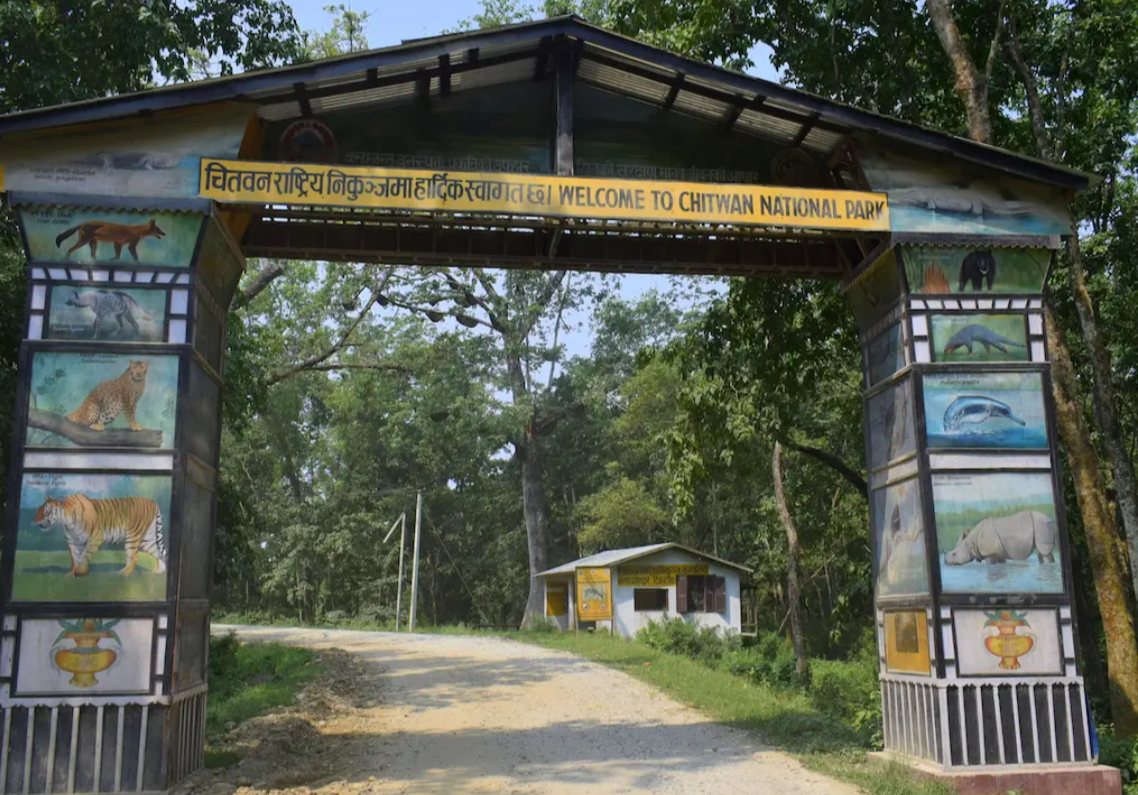
This national park extends from the Shiwaling mountain in Inner Madhesh to the border of India. Rapti, Narayani, and Riu are the rivers that flow through this national park.
| Headquarter: Kasara |
| Things to do: Jungle Safari, Jungle walk, Elephant Safari, Visiting Tharu Culture & Foods, Jeep Drive |
| Birds & Wildlife: 525 species of birds, 49 species of amphibians, 56 species of mammals, 3 species reptiles |
| Rivers: Rapti, Narayani, Reu |
| Best Season: April - June ( Up to 40 degree Celsius), July - September (Monsoon), Oct - March (Average) |
| Major Attractions: One-horned Rhino, Elephant, Sauraha, Meghauli, Kasara, Devghat, Balmiki Ashram, Bishajari Tal, etc. |
2. Langtang National Park
Langtang National Park was established in 1976. This is Nepal's first Himalayan national park. And, it is the fourth protected area. This park is spread in Nuwakot, Rasuwa and Sindhupalchok districts. Its area is spread over 1710 square kilometres. Similarly, it covers a buffer zone of 420 square km. As this National park is spread over the Himalayan region, the Langtang Glacier, Red Pond, Gosai Kund, etc. are located here. Similarly, about 25 per cent of the area here is completely covered with forest. Trekking, Mountaineering and Hiking, are activities that can be done here.
Wild dogs, Red Pandas, Pika, Muntjac, Musk Deer, Himalayan black bears, Himalayan Thar, Goral, Serow, Rhesus Monkey, Common Langur, Snow Leopard etc. are the major wild animals found here. The most famous Gosainkunda of Nepal also belongs to Langtang National Park. A big fair is held here every year on Janapurminda day.
| Headquarter: Dhunche, Rasuwa ( 117 KM from Kathmandu) |
| Things to do: Trekking, Hiking, Mountaineering, Observe Tamang Culture, Camping, etc. |
| Weather: March - May ( Average) , June - September ( Monsoon), Oct - February ( Cold) |
| Birds & Wildlife: 373 species of birds, Snow leopard, Red Panda, Pika, Muntjac, Musk Deer, Himalayan black Bear, Himalayan Thar, Goral, Serow, Rhesus Monkey, Common Langur, etc. |
| Major Attractions: Gosaikunda, Langtang Valley, Tamang Culture, Panchpokhari, Langtang & Jugal Mountain Range, etc. |
3. Shey - Phoksundo National Park
She Phoksundo National Park is spread over Dolpa and Mugu districts in the central western part of Nepal. It was established in 1984. The objective is to properly protect and enrich the ecological system, wildlife diversity, environment in this area. Its area is 3555 square kilometers. Similarly, an area of 1349 square kilometers is in the form of a buffer zone. She Phoksundo National Park is the largest national Park of Nepal. This Park is spread from 2130 meters to 6883 meters height.
Phoksundo Lake, a deep and large central lake of Nepal, also falls in this Park. Similarly, the highest Suligarh waterfall in Nepal is also located in this area. Similarly, Ringbo village, She Gumba, Dhaulagiri, Suligadh Valley, Kanjiroba Himal, etc. are the main attractions here. Entry to She Fuksudo Park costs Rs 25 for Nepalese, Rs 1500 for SAARC countries and Rs 3000 for other foreigners.
| Headquarter: Sumduwa |
| Things to Do: Trekking, Hiking, Mountaineering etc. |
| Best Season: March, April & May |
| Rivers: Suligad, Jugdual Rivers, Thulo Bheri, etc. |
| Birds, Butterflies: 200 species of birds, 29 species of butterflies |
| Wildlife: snow leopard, grey wolf, musk deer, blue sheep, goral, great Tibetan sheep, Himalayan Thar, leopard, jackal, and Himalayan black bear |
| Vegetation: 286 floral species of ethno-botanical |
| Attractions: Shey Monastry, Phoksundo Lake, Sulighad Waterfall, Dhaulagiri, Kanjiroba, Ringmo village |
4. Rara National Park
Rara National Park is located in Mugu & Jumla district in the western part of Nepal. Mugu District is a Himalayan District of Karnali Province. It was established in 1976 AD. Likewise, its area is 106 square kilometres. Rara National Park is the smallest national park of Nepal. The largest Rara lake in Nepal is located in this park. In terms of biological diversity, wildlife, and natural resources, this park is very beautiful and amazing. Many types of birds, wildlife, natural resources, and ecosystems are found here. An area of 198 square kilometres is a buffer zone in Rara National Park. Rara National Park can be reached via both air and land routes. Situated at a flying distance of 55 minutes from Kathmandu to Nepalgun. And, approximately 35 minutes from Nepalgunj to Talcha Airport in Mugu, the park's headquarters are about a three-hour walk from Talcha Airport.
Furthermore, RNP hosts endangered faunal species like the Red Panda and Musk Deer. It shelters 54 mammal species and 296 bird species, with over 49 species of migratory birds. The park actively preserves the higher altitude landscape, serving as a habitat for various flora and fauna. The predominant vegetation includes blue pine, different rhododendron species, Himalayan spruce, Himalayan cypress, and Lauth salla.
| Headquarter: Hutu, Mugu, Karnali |
| Things to do: Trekking in Rara, Hiking, Camping, Sightseeing, Birds Watching etc. |
| Best Season: Febrauary, March, April, October, November |
| Rivers: Karnali, Nijar, |
| Vegetation: Blue Pine Forest, Fir Forest, Birch-Rhododendron Forest and Alpine Meadows, Rhododendron, Black juniper, West Himalayan spruce, Khashru, and Himalayan cypress, Birch, Indian horse–chestnut, Walnut, Prunus rafa, Potentilla fruticose, Polygonatum, Rhododendron lepidote, |
| Floristic Diversity: 1070 species of vascular plants, 16 species of endemic flowering plants, |
| Faunal Diversity: 50 mammal species, 272 birds species, 49 species of water birds |
5. Khaptad National Park
Khaptad National Park is located in the far western region of Nepal. This park is spread in Bajhang, Bajura, Achham and Doti districts. It was established in 1984. This national park covers an area of 225 square kilometers. Similarly, there is a buffer zone of 216 square kilometers around it. It is spread at an altitude of 1400 meters to 3500 meters from the sea level.
Khaptad National Park is a land adorned with biological diversity, diversity in geography, diverse ecological systems. Endangered plants, animals and other ecological systems are living here. 224 species of herbs, 270 species of birds are found here. Similarly, animals such as goral, langur, barking deer, wild boar, partridges, flycatchers, bulbuls, monkey are found here.
In the 1940s, Khaptad Baba attained siddhi through meditation and penance in this area. There are enough natural, historical and religious places here.
| Headquarter: Khaptad |
| Things to do: Trekking, Hiking, Bird Watching, etc. |
| Best Season: March, April, May, October, November (15 - 20 degrees Celsius), June, July, August & September ( Monsoon), December, January & February (Snow Fall) |
| Wildlife: 20 species of mammals (barking deer, wild boar, goral, Himalayan black bear, yellow-throated marten) |
| Birds & Vegetation: 175 species of birds, 224 species of medicinal herbs |
| Others Attraction: Khaptad Baba Asram, Nagdhunga, Kedardhunga, Badi Malika, Khaptad Lake, Tribeni etc. |
6. Sagarmatha National Park
Everest National Park is the highest national park in the world. It is spread in the northeastern region of Nepal. It was established on July 19, 1976. Later, in 1979, Everest National Park was included in the World Heritage List. Its area is 1148 square kilometers. Similarly, an area of 275 square kilometers is covered by the buffer zone. The world's highest peak Mount Everest is located in this area.
Sagar means sky and Matha means head. It means, the head touching the sky. Everest is in Solukhumbu district. Being a Himalayan district, there is heavy snowfall and winter here. This park has a Himalayan ecosystem. Everest, Gokyo, Namche, etc. are attractive places here. Dudhkoshi and Imjakhola are the main rivers here.
You can reach Lukla directly by plane from Kathmandu. And from there the walk begins. Similarly, you can go by bus to Jiri, and from there you can reach here by trekking. It is especially crowded with foreign tourists. This Park, which is famous in the world, has enough hotels with facilities for food and accommodation.
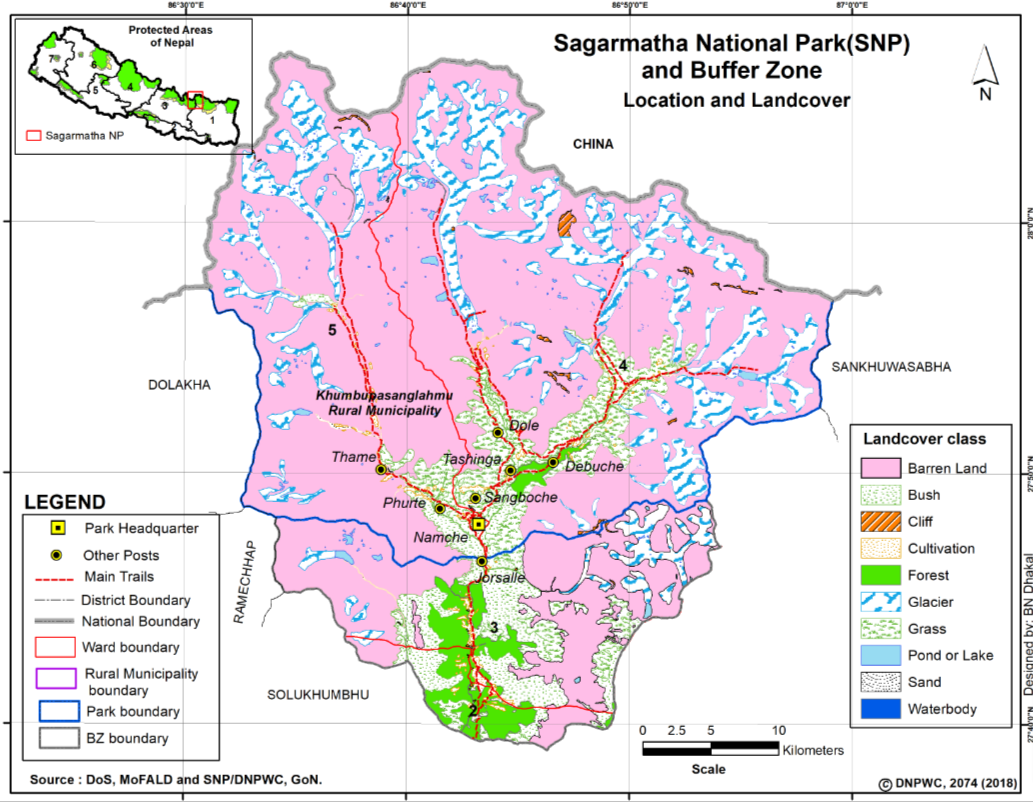
| Headquarter: Namche Bazar |
| Things to do: Trekking, Mountaineering, Camping, Sightseeing etc. |
| Rivers: Dudhkoshi, Imjakhola etc. |
| Major Glaciers: Khumbu, Imja, Ngozumpa and Nangpa |
| Major Peaks: Sagarmatha (8,848 m), Lhotse (8,501 m), Cho Oyu (8,153 m) and Nuptse (7,896 m) |
| Wildlife & Birds: Snow Leopard, Musk Deer, Red Panda, Pika (mouse hare), weasel, jackal, & 118 species of birds |
| Best Season: March, April, May, October, November / December, January & February (Snow Fall), / June to September (Monsoon) |
7. Bardiya National Park
Bardia National Park is the largest national park spread across the Terai region of Nepal. Its area is 968 square kilometers. Similarly, an area of 327 km is in the form of a buffer zone. It was established in 1976 in the name of Karnali Wildlife Reserve. Later in 1982 it was named Bardiya Wildlife Reserve. Similarly, in 1988, it was given the status of National Park.
Bardia National Park is home to some of the world's most endangered ecosystems. One-horned rhinoceros has been moved from Chitwan to Bardiya several times. Bardiya Park has the environment that a single-horned rhinoceros needs. Similarly, the Bengal tiger, dolphin and other animals are found in Bardiya.
| Headquarter: Thakurdwara |
| Things to do: Jungle Safari, Local Culture, Sightseeking, Boat Ride, Jeep Ride etc. |
| Rivers: Karnali, Babai etc. |
| Climate: Oct - April(Dry), April to July (Hot), July - September (Rainy) |
| Birds & Wildlife: 230 species of birds, 30 mammals including the Royal Bengal Tiger, one-horned rhinoceros, elephant, reptiles |
| Transportation: By Bus & Airplane (From Kathmandu) |
8. Makalu Barun National Park
Makalu Varun National Park is located in the Solukhumbu and Sankhuwasabha districts of the eastern region of Nepal. Its area is 1500 square kilometres. The area of 830 square kilometres around this area is in the form of a buffer zone. To the east of this park lies the Sagarmatha National Park. This is a Park in the Himalayan region of Nepal. Therefore, there are abundant mountain ecosystems. Snow leopards, snow leopards, snow leopards, etc., which are rare in the world, are found here.
Makalu Himal, Varun Valley, Chamlang, Mira Peak etc. are the attractions of this Nikunj. In this area, there are studies about the existence of the Yeti from time to time. In terms of topography, climate, wildlife, and vegetation, the ecological system of this park is very special.
| Headquarter: Seduwa |
| Things to do: Trekking, Mountaineering, Camping etc. |
| Peaks: Mt. Makalu (8,463m), Mt. Chamlang (7,319m), Mt. Baruntse (7,129m). Mera Peak (6,654m) |
| Vegetation: 25 species of rhododendron, 47 types of orchids, and 56 rare plants, 87 species of medicinal herbs, 86 species of fodder trees, |
| Birds & Wildlife: 400 species of birds, Endangered red panda and snow leopard, Himalayan black bear, clouded leopard, Himalayan marmot, 84 varieties of fish including salmon |
| Climate: October - February ( Cold/Snow Fall), March - June ( Best weather), July - September (Monsoon) |
| Entrance Fee: Nepali -NPR 25 per person, SAARC nationals -NPR 1,500 per person, foreigners - NPR 3,000 per person |
9. Shivapuri Nagarjun National Park
Shivpuri Nagarjuna National Park is a Park with a beautiful ecosystem attached to the capital of Nepal. It belongs to Kathmandu, Sindhupalchok, and Nuwakot districts. Its area is 159 square kilometres. Similarly, the surrounding area of 118 square kilometres is a buffer zone. It was established in 2002. This is the ninth National Park of Nepal.
Shivapuri is located in an area where subtropical and temperate climates meet. There are different types of natural forests like pine, oak, and rhododendron in the region, depending on the altitude and direction. The park has recorded various wildlife species such as the Himalayan Black bear, leopard, jungle cat, and rhesus monkey. Additionally, 177 bird species, including at least 9 threatened ones, inhabit the park. There are also 102 butterfly species, some of which are rare and endangered, along with 129 types of mushrooms.
| Headquarter: Shivapuri |
| Things to do: Trekking, Hiking, Bird watching, Religious Tour, Camping, etc. |
| Vegetations: 1402 species of plants, 123 species of orchids, 131 species of pteridophytes, 129 species of mushrooms |
| Birds & Wildlife: 177 species of birds, 124 species of butterflies, 122 species of insects, 348 species of birds, 65 species of mammals |
| Best Season: March - May, June - September (Rainy), Evergreen Distination |
10. Banke National Park
Banke National Park is the 10th Park established in Nepal. It is spread in Banke, Salyan, and Dang districts of the Western Terai region of Nepal. Its area is 550 square kilometres. Similarly, an area of 344 square kilometres is in the form of a buffer zone. It was established in 2010.
The park protects animals like tigers, striped hyenas, and four-horned antelopes. Additionally, it contains eight different ecosystems, such as mixed hardwood forests, Sal forests, Bhabar, and the foothills of the Chure range.
| Things to do: Hiking, Bird Watching |
| Bio-diversity and habitat: 124 plants, 34 mammals, more than 300 birds, 24 reptiles, 7 amphibians and 58 fish species, Three species of mammals (tiger, striped hyaena, four-horned antelope), four species of birds (giant hornbill, black stork, Bengal florican, and lesser florican) and two species of reptiles (gharial crocodile and python) |
| Weather: October to April ( Dry), April - June (Hot), July - September (Monsoon) |
11. Shuklaphanta National Park
Shuklaphanta National Park is located in Kanchanpur district of Far West Province of Nepal. Its area is 305 square kilometers. Similarly, an area of 244 square kilometers is in the form of a buffer zone. This Park was established in 1976. When it was established, it was a hunting reservation. However, later it turned into a wildlife reservation. Again in 2017, it was developed as a National Park. Biodiversity, geographical diversity, are the main features here. Various types of wild animals and plants are protected here.
It extends from 143 meters to a height of 1386 meters. Dense forests, open grasslands, and wetlands are the main attractions of this Park. Biological ecosystems exist here.
| Headquarter: Majhgaon, Kanchanpur |
| Things to do: Jungle Safari, Bird Watching, Jungle Walking etc. |
| Birds & Wildlife: 700 floral, 456 bird, 56 reptile and 15 amphibian species. |
12. Parsa National Park
Parsa National Park is the 12th Park of Nepal. It is spread in Parsa, Bara, and Makwanpur districts of Central Terai region of Nepal. Its area is 627.39 square kilometers. Similarly, the area of 285 square kilometers is in the form of a buffer zone. It was established in 1984 as a wildlife reserve. However, in 2017, Parsa was converted from a wildlife Reserve to a national park. Therefore Parsa National park is the youngest national park of Nepal.
The reserve is home to various endangered species including wild Asian elephants, Royal Bengal tigers, sloth bears and leopards. Blue cows, sambars, chitals, pig deer, barding deer, langurs, rhesus monkeys, striped hyenas, wildcats and civets are also found in the reserve. The reserve is also home to more than 500 species of birds.
| Headquarter: Adhabar |
| Things to do: Jungle Safari, Jungle Walk, Bird Watching, Camping etc. |
| Birds & Wildlife: 500 species of birds, Blue bull, Sambar, Chital, Hog deer, Barding deer, Langur, Rhesus macaques, Asian elephant, Royal Bengal tiger, Sloth bear, Leopard, common Cobra, Common and banded Karit, Python and King cobra, |
| Vegetation: Sal forests compose about 90 percent of the reserve's vegetation |
| Climate: Winter (October-December), Spring (January-March), Summer (April-June), Monsoon (July-September) |
